
With the outbreak of war in September 1939, the Empire Air Mail Scheme was immediately suspended and postage rates returned to their earlier levels of 1s 6d from New Zealand and Australia to the UK and 1s 3d from the UK.
The frequency of flights from Australia to UK was reduced from three a week to
twice a week (Wednesday and Saturday) with the first war-time flight leaving
Sydney on Wednesday 6 September [2].
The last mail on EAMS has already been described.
War-time service: September 1939 - April 1940
Mail from New Zealand, September 1939
War was declared on 3 September, 1939. The UK flying boat base had been moved from Southampton to Poole on 1 September with the first flight to Australia from Poole being on 7 September [4]. The frequency of the service was reduced from three times a week to twice a week.
The EAMS rate of 1½d per half oz was increased to 1s 6d from New Zealand to UK and to 1s 3d from UK. The first flight SW 169 from Sydney at the new rate was on Wednesday 6 September with the next flight SW 170 on Saturday 9 September [4].
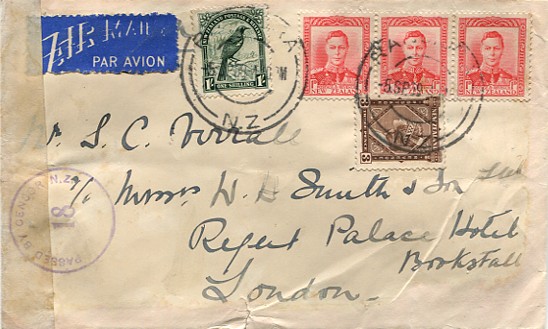
The new rate of 1s 6d was announced in New Zealand on 4 September. This cover to the UK is postmarked on the next day, 5 September 1939.
As war was expected, a Controller of Censorship for New Zealand had been appointed on 2 September 1939. (An overview of postal censorship in New Zealand is given in [9].)
The cover has been opened by the censors in Wellington (number 18) [3] and is the earliest censored cover that I have seen. It has been sealed by a blank tape as printed New Zealand censor tapes were not introduced until October.
The Evening Post stopped giving shipping information after 28 August [10] when it listed the Mariposa as being due to leave Auckland on 1 September, the Maunganui as being due in Wellington on 8 September and the Wanganella being due in Auckland on 12 September.
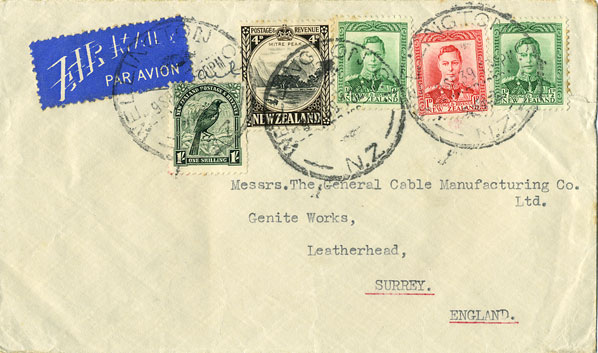
The Sydney Morning Herald continued until 4 September [11] and reported that the next dispatch from New Zealand after 1 September was scheduled for 9 September from Wellington on the Maunganui arriving in Sydney on 13 September. If this schedule was followed, the first wartime dispatch from New Zealand would have missed the third flight from Sydney on 13 September and been flown on the fourth flight SW 172 on 16 September which arrived in Poole on 27 September [12].
The next cover is postmarked in Wellington on 9 September 1939 and is likely to have been sent on the first dispatch at the new rate from Wellington later that day.
In this case, there are no censor marks, which was normal for early wartime air mail to UK.
The Auckland Star on 31 October 1939 reported a complaint by a member of the
House of Lords about delays caused by New Zealand censorship.
He reported that an airmail letter postmarked in Wellington on 5 September had
not been received by him in the UK until 20 October.
A possible reason for the delay is that it was franked at the EAMS rate and after arriving in Australia on 13
September was sent by sea.
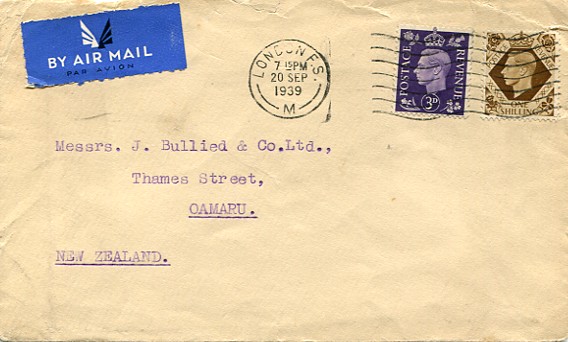
Mail to New Zealand, September 1939
This cover is postmarked in the UK at 7.15 pm on 20 September 1939 and is addressed to Oamaru in the South Island. There are no censor marks.Not clear if it would connect with the next flight SE 179 which left Southampton early on the morning of 21 September. Coogee had to return due to bad weather and left again on 22 September. It had then to return to Marseilles on 23 September due to mechanical trouble and spent the night there. It arrived in Sydney on 4 October.
Champion flew the mail on the following flight on 24 September, but
had mechanical problems on 25 September and stayed in Corfu for several days.
Clio flew the mail from Corfu on 27 September. and the mail arrived in Sydney on 7 October.
Introduction of Printed Censor Tapes
Printed censor tapes were first used in early October 1939. I have seen a cover to UK postmarked on 2 October and censored in Christchurch that had a blank censor tape and so printed tapes were not yet available there at the beginning of October.
I have seen a cover to the UK with a printed censored tape postmarked on 9 October with a Manchester redirection postmark on 31 October. Not clear how quickly it was dealt with by the censors, but it would be flown on SW 181 that left Sydney on 18 October and arrived in Southampton on 29 October [4]. It must have left New Zealand by 13 October which means that printed censor tapes were in use on or before that date. Interesting to know if any covers with a printed censor tape were flown from Sydney before SW 181.
I have seen a cover to Italy postmarked 11 September with a printed censor tape, but as its Milan arrival backstamp is not until 31 October, it was held up by the censors for about a month and so does not contradict an October start date for printed censor tapes. It would also have been flown on SW 181.
Other early printed tapes that I have seen are on a surface cover to Switzerland postmarked 25 September and both a surface and an airmail cover to Denmark both postmarked on 27 September. None of these covers have an arrival date and so it is not possible to determine how long they were in the censor process.
Later Mail from New Zealand


To Netherlands, October 1939
Mail to non-empire countries had of course not been flown at the EAMS rate and so there was not such a drastic change in airmail rates.
This cover is postmarked in Auckland on 12 October 1939 and is addressed to Eindhoven. It may have be flown to England on SW 181 that left Sydney on 18 October and arrived in Southampton on 29 October [4], but may have been delayed by the censors.
Although the UK flying boat base had been moved from Southampton to Poole in Dorset on the outbreak of war, it was moved back to Southampton in the middle of October. (It was moved back to Poole in January 1940.)
The cover has franking of 2s. It was opened by the censor and is a very early use of the censor tape with a two line inscription that was to remain in use until April 1941. The censor number is 77 which Startup & LaBlonde list as an Auckland number [3].
I have been sent a scan of an earlier cover to Switzerland postmarked on 6 September in Napier that has an arrival datestamp
on 12 October which suggests that it was sent on SW 176 that left Sydney on 30 September and arrived in Brindisi on 11 October.
It was therefore delayed, presumably by the censors in Wellington, for about a fortnight.
It has been sealed by a blank censor tape as the imprinted censor tapes were not issued until October.
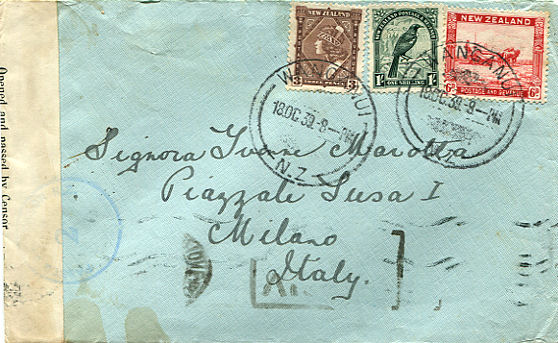
To Italy, October 1939
This cover is postmarked in Wanganui on 18 October 1939, is addressed to Milan and is franked with 1s 9d. It was opened and passed by the censor in Auckland (censor number 2). Again this early use of censorship is to a foreign country.

The backstamps are not too easy to de-cypher. There is an Athens backstamp and the date appears to be 14 November while the Milan backstamp appears to be 17 November. That would tie in with it being flown on SW 186 on 4 November from Sydney which arrived in Athens on 13 November. So, again there was a delay caused by the censor.
As it has an Athens backstamp, it was presumably unloaded there
and sent from there to Milan.
That leaves the question of why was it not flown all the way to Italy by Imperial Airways
as that would have given a faster connection with Milan.
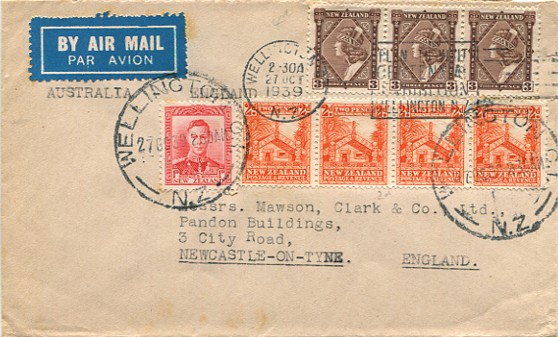
To Britain, October 1939
Cover postmarked in Wellington on 27 October 1939 and addressed to Newcastle on Tyne.
As seems to be normal with early WW2 air mail to UK, it has no censor markings.
In a survey of 800 covers in 1988, the first use of the tape with Opened and passed by Censor in New Zealand was 26 October 1939 [7]. while a follow up in 1992 shows a letter to Finland censored on 4 October 1939 [8]. That letter is postmarked in Christchurch, but the censor number is 2 which Startup & LaBlonde list as an Auckland censor number [3].
I have recently been shown two covers with printed censor labels that were postmarked in September 1939. The first is to Switzerland and is postmarked on 25 September while the other is to Denmark and is postmarked on 29 September. Both were dealt with the censors in Wellington (censor number 17 and 18).
There was 100% censorship of mail to non-Empire countries from the start, but in the early months most of the air mail to the
UK was not sent to the censors.
To South Africa, January 1940
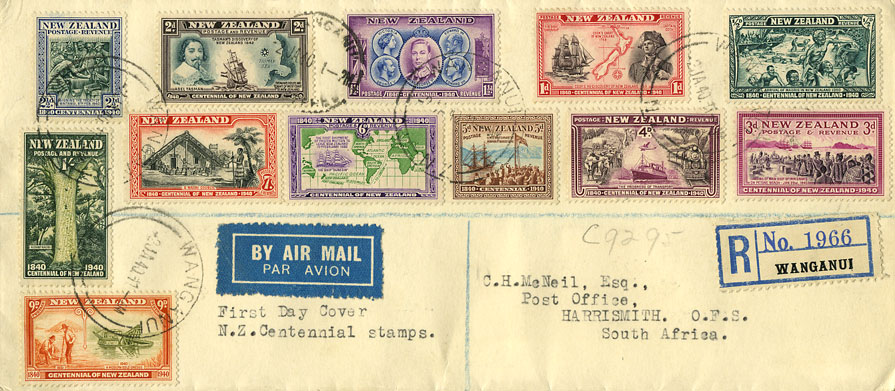
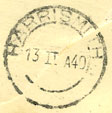
This registered airmail cover to South Africa is franked with the complete Centennial set and is postmarked on the first day of issue, 2 January 1940. It is backstamped in Harrismith on 13 February.
After being sent to Sydney by sea, it was likely flown on SW205 on 10 January
arriving in Alexandria on 18 January.
The 1940 winter was very severe and Poole Harbour was ice-bound from 20 - 22
January.
No flight for Durban left Poole between DS247 on 13 January and
DS248 on 4 February.
DS248 arrived in Alexandria on 7 February and in Durban on 11 February
which fits with the 13 February backstamp on the cover [4].
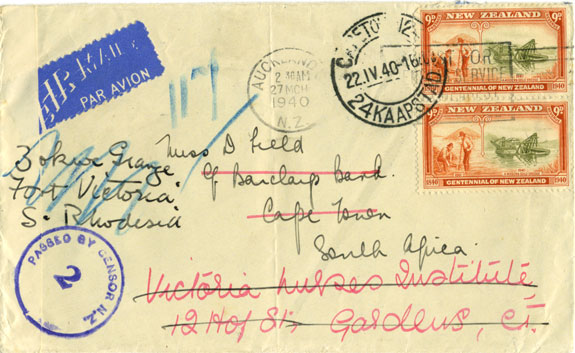
To South Africa, March 1940
This censored cover is postmarked at 2.30 am on 27 March 1940 in Auckland and is addressed to Cape Town. After being sent to Sydney by sea, it would be flown on the Eastern Route to Alexandria.
BOAC replaced Imperial Airways on 1 April 1940 and so this cover was flown on one of the first BOAC flights.
It was flown either on SW 229 that left Sydney on 3 April and arrived in Alexandria on 11 April or SW 230 that left three days later and arrived in Alexandria on 14 April. The connection with the BOAC African Route would be with flight DS 261 that left Alexandria on 15 April and arrived in Durban on 18 April or with DS 262 that left Alexandria on 16 April and arrived in Durban on 19 April [4]. Both would have given sufficient time for the Cape Town postmark of 22 April [4].
It was readdressed twice in Cape Town, once to a local address and once to Southern Rhodesia and has a Cape Town postmark of 22 April. Both the new addresses are scored out and there are no further transit marks and so its final destination is not clear.
It is franked with 1s 6d which is significantly less than the pre-EAMS
rate from New Zealand to South Africa of 2s 9d.
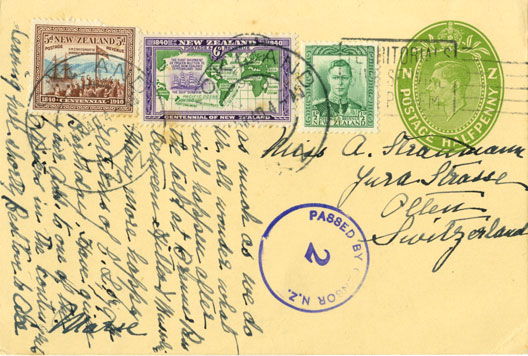
To Switzerland, March 1940
The next example is a postcard addressed to Switzerland and has franking of 1/- which was half the letter rate.
It is postmarked on 21 March 1940 and was passed by the censor in Auckland. The regular trans-Tasman airmail did not start for another six weeks and so the journey to Australia was still by sea. It would then have been flown from Australia to Brindisi in Italy [3], likely on SW 227 that left Sydney on 27 March [4] and arrived in Brindisi on 6 April before being carried on the final leg to Switzerland by rail.
When the trans-Tasman airmail started the airmail rate to Switzerland was increased to 2/6.
BOAC replaced Imperial Airways on 1 April 1940 which
means that the change-over occurred while this card was in transit.
Mail to New Zealand
The UK flying boat base was moved from Southamton to Poole in Dorset on 1 September and flights resumed from there on 5 September with the first flight to Australia leaving on Thursday 7 September [2]. The frequency of flights from UK to Australia was reduced from three a week to twice a week (Thursday and Sunday).
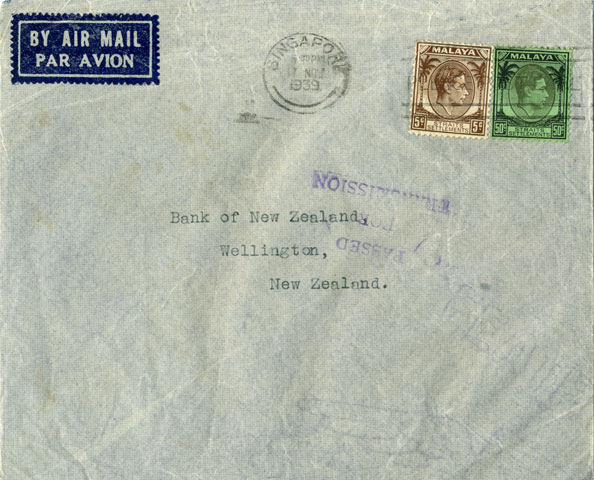
From Singapore
This cover was is postmarked in Singapore at 5pm on 17 November 1939 and was flown from there, likely on SE 194 that left Singapore on 20 November and arrived in Sydney on 23 November. It completed its journey to New Zealand by sea.
It is franked with 55c in Straits Settlements stamps. The pre EAMS rate had been 25c and it is not clear why there was such a large increase.
It was not opened by the censor, but there is a Passed for Transmission rubber stamp in purple.
The regular trans-Tasman airmail
to Australia was at last opened in April 1940 providing,
for the first time, a regular all airmail route between New Zealand and the UK.
All scans were made by the author.
[1] Aircraft Movement on Imperial Airways' Eastern Route, vol 2 1937-39
Peter Wingent, Winchester 2005.
[2] W.H. Legg, Early Wartime Airmails,
Air Mail News, vol 46, pp 197-204, November 2003.
[3] The Postal History of World War II Mail between New
Zealand and Switzerland, R.M. Startup and C.J. LaBlonde, 2005.
[4] Bridging the Continents in Wartime: Important Airmail Routes 1939-45,
H. E. Aitink and E. Hovenkamp, SLTW, Enschede, 2005.
[5] Airmails of New Zealand, volume 2 (1986) compiled by
Douglas A Walker,
Air Mail Society of New Zealand
[6] Civilian Postal Censorship in World War II Some Facts and Problems,
G. Branam, The Kiwi, vol 43, pp 90-97, September 1994.
[7] Civilian Postal Censorship in New Zealand in World War II, Rodney Stone,
The Mail Coach, vol. 25, no. 1, pp 3-7, October 1988.
[8] Letter to the Editor, J Lindley,
The Mail Coach, vol. 28, no. 5, p 190, June 1992.
[9] Postal Censorship in New Zealand 1939-1945, R.M. Startup,
The Mail Coach, vol. 23, no. 6, pp 243-247, August 1987.
[10] Evening Post Wellington 1916-1945, Papers Past,
available at: paperspast.natlib.govt.nz/cgi-bin/paperspast
[11] Australian Newspapers 1803-1954,
Trove, National Library of Australia
[12] Beginning and End of the Empire Air Mail Scheme from New Zealand, R Clark, The Kiwi, vol 63,
pp 120-123, September 2014.
[13] Early WWII Postal Censorship in New Zealand, R Clark, The Kiwi, vol 65,
pp 118-120, July 2016.